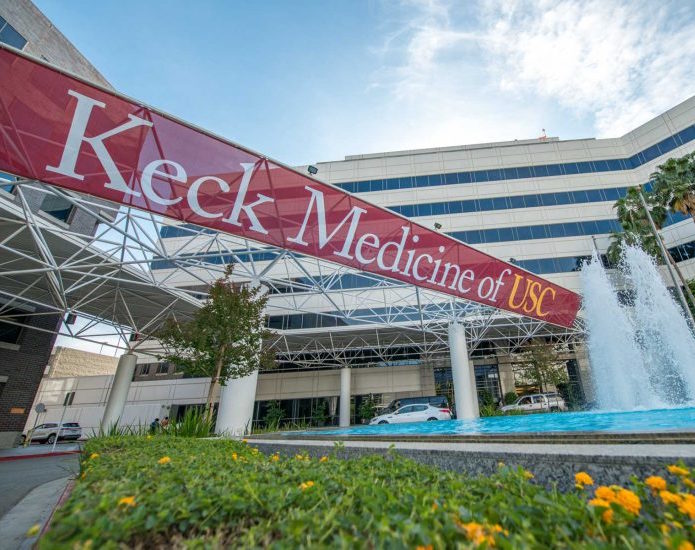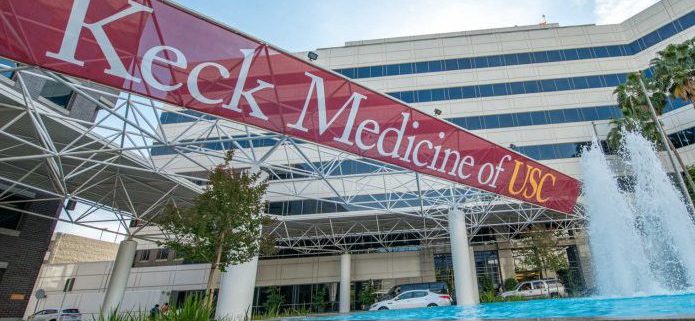USC schools create protective equipment for hospitals

Foreseeing personal protective equipment shortages for health care workers treating coronavirus patients, Keck Medicine of USC sent a plea to other USC schools for personal protective equipment donations on March 18. Within days, faculty and staff initiated a virtual collaboration using their makerspaces, laboratories and materials to not only donate existing supplies but also to produce their own.
Initially, teams from different schools focused on prototyping separate pseudo N95 respiratory masks and face shields, the face gear most commonly used among health care workers as preferred by the Centers for Disease Control and Prevention. Groups such as the Iovine and Young Academy Makerspace and the School of Architecture’s Operation PPE Network focused on creating face masks while the Armani Research Lab and other USC groups experimented with developing additional equipment essential to PPE maintenance, including an ultraviolet cleaning system that would allow for PPE to be reused.
As projects among the schools developed, engineering professor Satyandra Gupta, the director of the Center for Advanced Manufacturing, decided it was time to unify efforts between schools and teams by organizing a virtual symposium to clarify design standards and the donation drop-off process.
“We have to bring the entire community together to make sure we understand overall what the needs are and then figure out what role each of us can play … so that all of us can learn from Keck people as to what really is needed, how many quantities, which design they like, have tested and believe are going to work,” Gupta said.
Sixty-seven Keck Medicine and USC faculty, staff and doctoral students attended the symposium, held Friday over Zoom. In the symposium, Kymberly Lengyel, an associate administrator of infection control at Keck, informed attendees that Keck will require twice the amount of disposable PPE they currently use for the six- to eight-week-long surge it is expecting in the near future. In other words, Keck will need 2,000 N95 masks and 2,000 face shields per day to be ready during this surge period.
As of April 2, Keck is treating nine confirmed coronavirus patients and evaluating 11 suspected cases of the virus, Lengyel told attendees.
Team leaders presented the designs they were using for the machines they had available but agreed not to enforce a standard design given each team’s differences in production tools and capabilities. The donation procedure to contribute to supplies is public on Keck’s website. After delivering parts to drop-off locations, Darryl Hwa Hwang, an assistant professor of research radiology, picks them up and delivers them to Keck where the parts are evaluated for quality by Lengyel and then assembled under hygienic standards.
Hwang is the point person for collecting donations and communicating with the multiple groups working to produce PPE. In his current position, Hwang provides input on equipment models and interacts with infection prevention specialists on the quality and utility of the products.
“I realized that I was in a unique position where I can get prototypes tested to see their efficacy and also interact with infection prevention to make sure that they’re happy with whatever we’re making,” Hwang said. “Because of that link, I got drawn into multiple existing projects.”
As each of the schools hunkered down on their part in supporting local health care workers, Andrea Armani, the Ray Irani Chair in chemical engineering and materials science, and her team spent three days prototyping, testing, building and deploying an ultraviolet light system to disinfect face shields for reuse. Her team worked from home, as most on-campus laboratories are closed. They’ve sent 45 of the systems to hospitals in Southern California.
“We’re talking at-home 3D printers, putting shields together in their bedrooms or living rooms or dens, and it’s a matter of how many members of my lab are doing this in their spare time,” Armani said. “Right now, it’s about five members of my research group as well as my husband and I and members of the community.”
Armani’s lab has partnered with the School of Architecture and the IYA’s Makerspace to use 3D printing and laser-cutting technologies to produce 6,000 reusable face shields. In collaboration with Keck and local manufacturing companies, the lab made the face shields easier to create by shifting the positioning of the headband pegs slightly upward to make them more compatible with a broader range of 3D printers.
Seth Wieman, the foreman of the Viterbi/Dornsife Machine Shop, has also produced face shields alongside two other staff members. The shop’s initial production phase is about 200 face shields, with higher-scale production ramping up in the coming weeks.
Others within the School of Architecture have also put their skills to use to combat the virus. Alvin Huang, an associate professor of architecture, has mobilized more than 200 volunteers to use 3D printers to print face shields and two sizes of pseudo N95 masks. In less than a week, his volunteer network of School of Architecture faculty, students, alumni and private firms has printed more than 2,000 combined pseudo N95 masks and face shields to distribute to Keck, L.A. County + USC Medical Center, Children’s Hospital Los Angeles and Martin Luther King, Jr. Hospital in South Los Angeles.
In a similar fashion, IYA is also creating face shields to supply to hospitals. Tucker Rae-Grant, the digital fabrication lab specialist of IYA’s Makerspace, took into consideration the fact that their team will most likely not be able to provide enough supplies to hospitals using 3D printing as they figured out what role they could play in producing PPE. With this problem in mind, Rae-Grant found an open source laser-cutting design for face shields from the University of Wisconsin-Madison, which he’s using to produce 400 face shields a week with the Makerspace’s three laser cutters, a rate that would have been faster than creating masks using a 3D printer.
Los Angeles Mayor Eric Garcetti visited the IYA Makerspace Sunday to show gratitude to the workers creating the face masks, while also creating three face shields himself.
“In a great partnership feedback between Keck, the school of medicine, and the hospitals that USC runs, they are able to look in real time and ask for changes in equipment … to help folks be able to make sure that they can stay safe while they are saving our lives,” Garcetti said in a Facebook Live video.
The face shield parts from all collaborating schools are dropped off at either the University Park or Health Sciences campus. There, the parts are then assembled under the inspection of Lengyel and the Keck infection prevention team.
“We have to … get that education out there to ensure that we are delivering the safest practices for the healthcare workers and making sure that they have the personal protective equipment to keep them safe and make sure they know how to use it correctly — donning and adopting it correctly each and every time they use personal protective equipment,” Lengyel said.
Other forms of PPE donations have come from other USC schools and institutes as well. The staff of the Wrigley Institute for Environmental Studies on Catalina Island rallied to find N95 masks in earthquake emergency kits and sent them along with N100 masks, safety goggles and safety glasses to the mainland over several shipments. School of Dramatic Arts Head of Production Elsbeth Collins and her production staff are sewing face mask covers to donate to Keck. Since dramatic productions have been canceled, Collins assembled sewing kits for her staff so that they could produce 160 to 200 mask covers per week.
Whether sewing, 3D printing or laser-cutting, the cumulative efforts of each team are to try and best prepare Los Angeles for increasing surges in hospitals, Lengyel said.
“It’s not just everybody at USC coming together but it’s really everybody in Los Angeles coming together — it’s bigger than USC,” Armani said. “Getting industry participation, family member participation, that’s really what’s so remarkable. Having faculty members collaborate with each other, that happens all the time. But getting industry to volunteer their time, to donate materials, that’s what’s really unique about what’s happening right now.”

